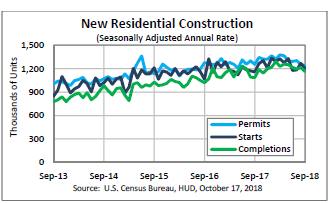Steel Markets

Housing Starts Drop More than Expected in September
Written by Sandy Williams
October 17, 2018
Housing starts dropped 5.3 percent in September to a seasonally adjusted annual rate of 1,201,000, falling more than expected by economists. Multi-family housing led the decline, falling 12.9 percent, compared to 0.9 percent for single-family homes. Compared to a year ago, starts were 6.4 percent higher, said the Census Bureau and HUD.
“Slight gains off the summer soft patch for single-family mirror a minor uptick of the NAHB/Wells Fargo Housing Market Index, now registering a score of 68,” said chief economist Robert Dietz at the National Association of Home Builders. “While builders are benefitting from recent declines in lumber prices (at least relative to spring and summer’s elevated levels), they continue to report concerns about labor access issues.”
The Northeast saw a 29 percent gain last month followed by an increase of 6.6 percent in the West. Starts fell 14.0 percent and 13.7 percent for the Midwest and South, respectively. The plunge in starts for the South was blamed on Hurricane Florence that swept over the region in mid-September.

Permit authorizations held relatively steady, dipping just 0.6 percent from August to a rate of 1,249,000. Single-family authorizations were up 2.9 percent month-over-month while housing of five or more units slid 9.3 percent.
Permit authorization fell in the Northeast and Midwest as the winter months approach. Authorizations in the West were the strongest at 11.1 percent and were mostly flat in the South at 0.6 percent.

Sandy Williams
Read more from Sandy WilliamsLatest in Steel Markets

CMC looks beyond Arizona micro-mill woes to long-term viability of construction mart
Despite the economic and geopolitical upheaval of the last five years, CMC President and CEO Peter Matt points out that the construction market has been an essential element of the way forward.

US importers face stricter rules under revamped S232 tariffs
“CBP expects full compliance from the trade community for accurate reporting and payment of the additional duties. CBP will take enforcement action on non-compliance," the agency said in a March 7 bulletin.

Steel exports rebound in January
US steel exports recovered to a five-month high in January after having fallen to a two-year low in December. This growth follows four consecutive months of declining exports.

Construction spending drops marginally in January
Construction spending edged down slightly in January, slipping for the first time in four months. The US Census Bureau estimated spending at a seasonally adjusted annual rate of $2,196 billion in January, down 0.2% from December’s downward revised rate. The January figure is 3.3% higher than a year ago. January’s result, despite the slight erosion, […]

HVAC equipment shipments slow in December but strong annually
Shipments of heating and cooling equipment in the US fell to an 11-month low in December, according to the latest data released by the Air-Conditioning, Heating, and Refrigeration Institute (AHRI).
